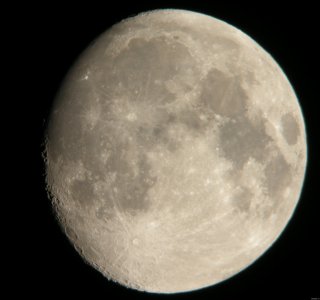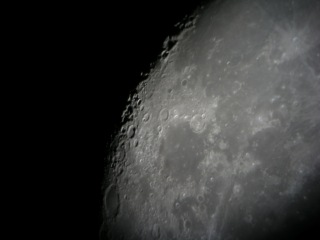While I wait for my computer to be resurrected for the second time in a week, here is last night’s shot of the Day Twelve moon. I’ll add commentary later, when I make the moon map. In the meantime, here is the “straight” image:
As always, if you’re having trouble seeing the whole image (should be over 2400 pixels wide), right-click the larger version and open it in a new tab.
Since I was so depressed about losing my computer again so soon after getting it back only last Friday (from the dizzying high of computer regained to the terrifying low of computer relost–where’s the creamy middle?), I decided to haul out my “big gun,” the 8-inch Schmidt-Cassegrain, and see if I could get any useful images from it.
The first thing I found out was that, whatever it has been like on previous nights, the seeing last night was not good. I wasn’t able to tell this on previous nights, because of the diminutive size of my spotting scope. The aperture is only 60mm, with a focal length of only 360mm. These dimensions don’t allow me to push the power too high when I use my favorite eyepiece, a 10mm Radian. (In case you aren’t aware, the power of an astronomical telescope, or of any optical system; your favorite binoculars, for instance) results from only two numbers: the focal length of the scope (in this case, 360) divided by the focal length of the eypiece (in this case, 10). So my spotting scope provides a power of 36x.
Then, since I’m digiscoping, I have to add in the focal length of the camera itself, which varies with the zoom setting I use; I rarely bother to provide this number, the effective focal length, although I should. The reason I don’t is that I’m rarely at no zoom or full zoom when digiscoping the moon. I zoom until the moon almost fills the frame, and leave it at that. For almost all the full moon shots in this series, the zoomed focal length was 12.9mm. I don’t know what that works out to in ozmeq with my Coolpix 5100; it’s somewhere between 35mm–no zoom–and 123mm–full 3.5x zoom. No zoom gives me 7.5mm; full zoom gives me 15.7. I can do math, but not very well. I’m going to guess that 12.9mm gets me a “35-mm equivalent” focal length of 90mm. So, plugging that into the equation, I get an efl of 4600!
I generally don’t push the spotting scope much higher than 36x, because the views become uncomfortable, dimmer, and harder to photograph, because the longer the focal length of your optical system, the longer your exposure needs to be. If I were to plug my “highest” power lens in, which provides a magnification of 120, my efl would jump to 15,000! Exposure time would be a bit of an issue, particularly since the camera tripod I mount this is on does not track the motion of the sky.
But last night, with a much larger scope on a much heavier and more stable mount (motorized to track the sky, too), I noticed the image of the moon blurring and sharpening in waves. This is typical of astronomical telescopes that haven’t adjusted to the ambient temperature; the difference in temperature generates air currents inside the scope that can interfere with the image. And with this system (focal length of 2000mm, aperture of 200mm), I was using 200x instead of the 36x from the smaller scope. This extra power enables you to see much more detail, but when that detail is swimming around, it’s a bit of a trade off.
In addition, the extra power reduces the field of view: there’s no way I can get the full disc of the moon into the eyepiece, but what does fit can be seen much better. Here’s the clearest image I got last night, featuring a couple of craters we talked about in the posts on Day 10 and Day 11: Gassendi and Mersenius, respectively.
Gassendi is the crater at the center of the image with another crater superimposed on its rim; Mersenius is to its left. The giant crater Schickard is just about fully illuminated now, at lower left of the image; it’s located to the southwest of Mare Humorum, on the other side of a dark area called the Lacus Excellentiae.
This much power sure makes cruising the moon inviting; I’ll try to set up the big scope more frequently for the rest of the month.



